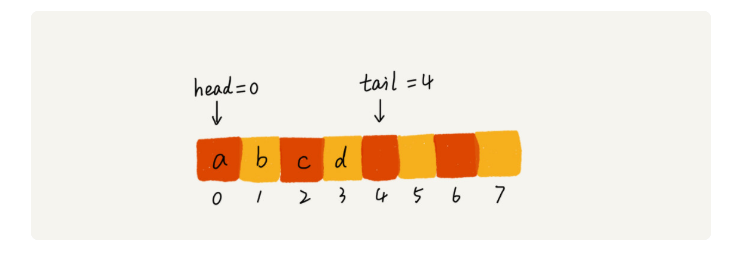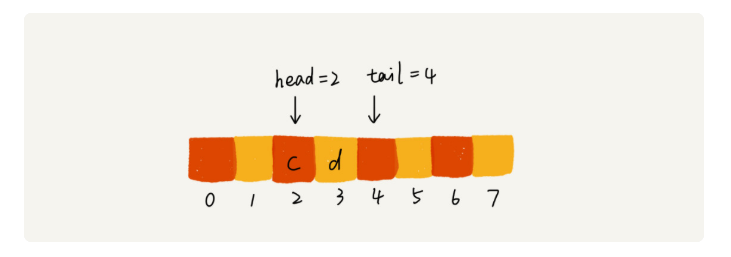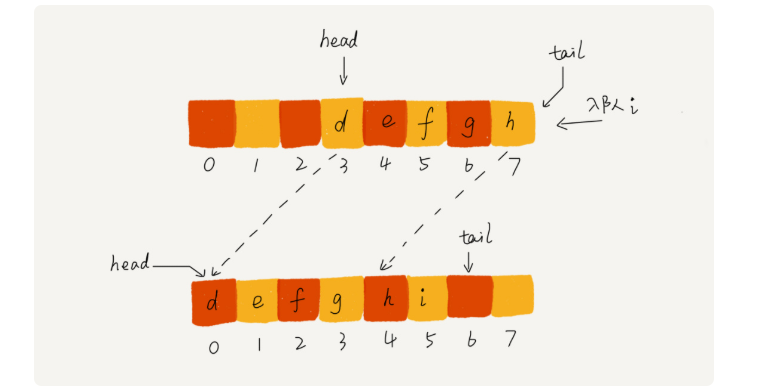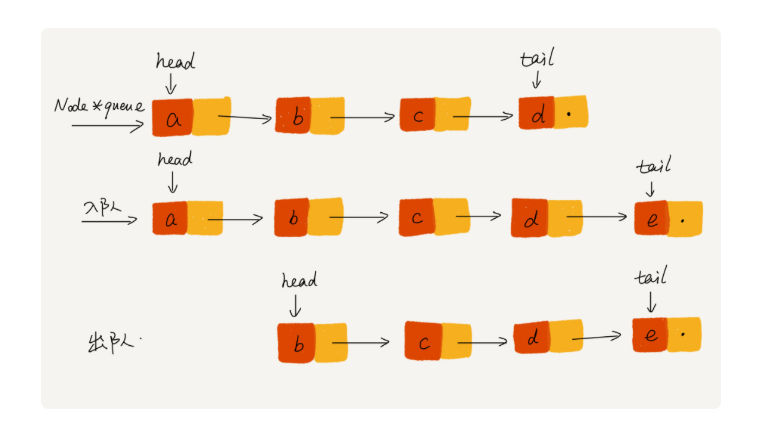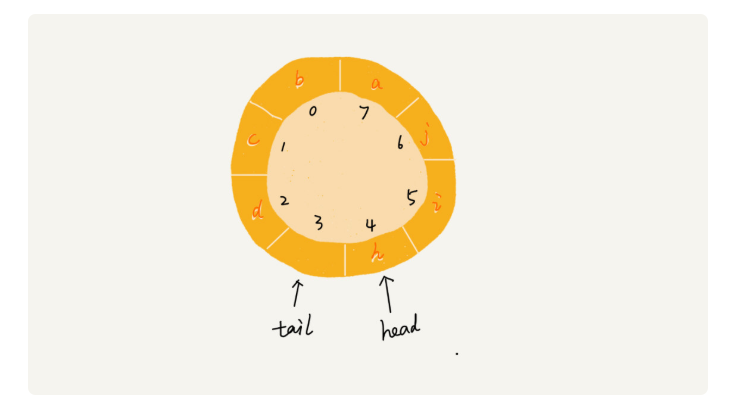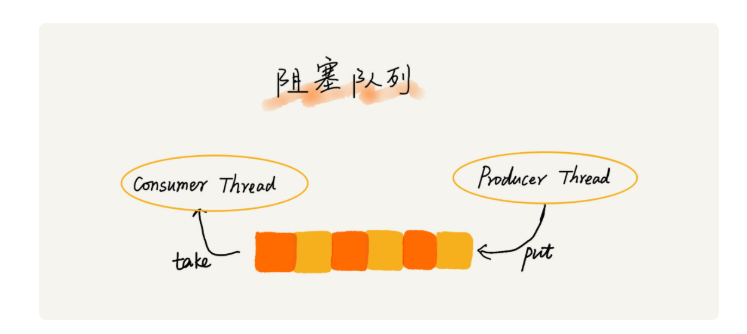学习自极客时间的《数据结构与算法之美》 作者:王争
队列 1. 什么是队列? 先进者先出,这就是典型的“队列”。所以,队列跟栈一样,也是一种操作受限的线性表数据结构 。
作为一种非常基础的数据结构,队列的应用也非常广泛,特别是一些具有某些额外特性的队列,比如循环队列、阻塞队列、并发队列。它们在很多偏底层系统、框架、中间件的开发中,起着关键性的作用。比如高性能队列 Disruptor、Linux 环形缓存,都用到了循环并发队列;Java concurrent 并发包利用 ArrayBlockingQueue 来实现公平锁等。
2. 顺序队列 跟栈一样,队列可以用数组来实现,也可以用链表来实现。用数组实现的栈叫作顺序栈,用链表实现的栈叫作链式栈。同样,用数组实现的队列叫作顺序队列,用链表实现的队列叫作链式队列。
2.1 顺序队列 数组实现队列用的是数组双指针 的方法。
1 2 3 4 5 6 7 8 9 10 11 12 13 14 15 16 17 18 19 20 21 22 23 24 25 26 27 28 29 from typing import Optionalclass ArrayQueue : def __init__ (self, capacity: int) : self._items = [] self._capacity = capacity self._head = 0 self._tail = 0 def enqueue (self, item: str) -> bool: if self._tail == self._capacity: return False self._items.insert(self._tail, item) self._tail += 1 return True def dequeue (self) -> Optional[str]: if self._head != self._tail: item = self._items[self._head] self._head += 1 return item else : return None def __repr__ (self) -> str: return " " .join(item for item in self._items[self._head : self._tail])
队列需要两个指针:一个是 head 指针,指向队头;一个是 tail 指针,指向队尾。
随着不停地进行入队、出队操作,head 和 tail 都会持续往后移动。当 tail 移动到最右边,即使数组中还有空闲空间,也无法继续往队列中添加数据了。在数组那里也可以提到,可以用数据搬移 。但是,每次进行出队操作都相当于删除数组下标为 0 的数据,要搬移整个队列中的数据,这样出队操作的时间复杂度就会从原来的 O(1) 变为 O(n)。
实际上,我们在出队时可以不用搬移数据。如果没有空闲空间了,我们只需要在入队时,再集中触发一次数据的搬移操作。 借助这个思想,出队函数 dequeue() 保持不变,我们稍加改造一下入队函数 enqueue() 的实现,就可以轻松解决刚才的问题了。下面是具体的代码:
1 2 3 4 5 6 7 8 9 10 11 12 13 14 15 def enqueue (self, item: str) -> bool: if self._tail == self._capacity: if self._head == 0 : return False else : for i in range(0 , self._tail - self._head): self._items[i] = self._items[i + self._head] self._tail = self._tail - self._head self._head = 0 self._items.insert(self._tail, item) self._tail += 1 return True
当队列的 tail 指针移动到数组的最右边后,如果有新的数据入队,我们可以将 head 到 tail 之间的数据,整体搬移到数组中 0 到 tail-head 的位置。
完整代码可以这样写:
1 2 3 4 5 6 7 8 9 10 11 12 13 14 15 16 17 18 19 20 21 22 23 24 25 26 27 28 29 30 31 32 33 from typing import Optionalclass DynamicArrayQueue : def __init__ (self, capacity: int) : self._items = [] self._capacity = capacity self._head = 0 self._tail = 0 def enqueue (self, item: str) -> bool: if self._tail == self._capacity: if self._head == 0 : return False self._items[0 : self._tail - self._head] = self._items[self._head : self._tail] self._tail -= self._head self._head = 0 if self._tail == len(self._items): self._items.append(item) else : self._items[self._tail] = item self._tail += 1 return True def dequeue (self) -> Optional[str]: if self._head != self._tail: item = self._items[self._head] self._head += 1 return item def __repr__ (self) -> str: return " " .join(item for item in self._items[self._head:self._tail])
3. 链式队列 基于链表的实现,我们同样需要两个指针:head 指针和 tail 指针。它们分别指向链表的第一个结点和最后一个结点。如图所示,入队时,tail->next= new_node, tail = tail->next;出队时,head = head->next。
1 2 3 4 5 6 7 8 9 10 11 12 13 14 15 16 17 18 19 20 21 22 23 24 25 26 27 28 29 30 31 32 33 34 35 36 37 from typing import Optionalclass Node : def __init__ (self, data: str, next=None) : self.data = data self._next = next class LinkedQueue : def __init__ (self) : self._head: Optional[Node] = None self._tail: Optional[Node] = None def enqueue (self, value: str) : new_node = Node(value) if self._tail: self._tail._next = new_node else : self._head = new_node self._tail = new_node def dequeue (self) -> Optional[str]: if self._head: value = self._head.data self._head = self._head._next if not self._head: self._tail = None return value def __repr__ (self) -> str: values = [] current = self._head while current: values.append(current.data) current = current._next return "->" .join(value for value in values)
4. 循环队列 要想实现一个循环队列,最关键的是,确定好队空和队满的判定条件。
当队列满时,图中的 tail 指向的位置实际上是没有存储数据的。所以,循环队列会浪费一个数组的存储空间。
1 2 3 4 5 6 7 8 9 10 11 12 13 14 15 16 17 18 19 20 21 22 23 24 25 26 27 28 29 30 from typing import Optionalfrom itertools import chainclass CircularQueue : def __init__ (self, capacity) : self._items = [] self._capacity = capacity + 1 self._head = 0 self._tail = 0 def enqueue (self, item: str) -> bool: if (self._tail + 1 ) % self._capacity == self._head: return False self._items.append(item) self._tail = (self._tail + 1 ) % self._capacity return True def dequeue (self) -> Optional[str]: if self._head != self._tail: item = self._items[self._head] self._head = (self._head + 1 ) % self._capacity return item def __repr__ (self) -> str: if self._tail >= self._head: return " " .join(item for item in self._items[self._head : self._tail]) else : return " " .join(item for item in chain(self._items[self._head:], self._items[:self._tail]))
5. 阻塞队列 阻塞队列其实就是在队列基础上增加了阻塞操作。 简单来说,就是在队列为空的时候,从队头取数据会被阻塞。因为此时还没有数据可取,直到队列中有了数据才能返回;如果队列已经满了,那么插入数据的操作就会被阻塞,直到队列中有空闲位置后再插入数据,然后再返回。
“生产者 - 消费者模型”就是利用的阻塞队列 。这种基于阻塞队列实现的“生产者 - 消费者模型”,可以有效地协调生产和消费的速度。当“生产者”生产数据的速度过快,“消费者”来不及消费时,存储数据的队列很快就会满了。这个时候,生产者就阻塞等待,直到“消费者”消费了数据,“生产者”才会被唤醒继续“生产”。
基于阻塞队列,我们还可以通过协调“生产者”和“消费者”的个数,来提高数据的处理效率。比如前面的例子,我们可以多配置几个“消费者”,来应对一个“生产者”。
6. 并发队列 线程安全的队列我们叫作并发队列。最简单直接的实现方式是直接在 enqueue()、dequeue() 方法上加锁,但是锁粒度大并发度会比较低,同一时刻仅允许一个存或者取操作。实际上,基于数组的循环队列,利用 CAS 原子操作,可以实现非常高效的并发队列。这也是循环队列比链式队列应用更加广泛的原因。在实战篇讲 Disruptor 的时候,我会再详细讲并发队列的应用。
问题思考 一. 当我们向固定大小的线程池中请求一个线程时,如果线程池中没有空闲资源了,这个时候线程池如何处理这个请求?是拒绝请求还是排队请求?各种处理策略又是怎么实现的呢?
我们一般有两种处理策略。第一种是非阻塞的处理方式,直接拒绝任务请求;另一种是阻塞的处理方式,将请求排队,等到有空闲线程时,取出排队的请求继续处理。 那如何存储排队的请求呢?
我们希望公平地处理每个排队的请求,先进者先服务,所以队列这种数据结构很适合来存储排队请求。我们前面说过,队列有基于链表和基于数组这两种实现方式。这两种实现方式对于排队请求又有什么区别呢?
基于链表的实现方式,可以实现一个支持无限排队的无界队列(unbounded queue),但是可能会导致过多的请求排队等待,请求处理的响应时间过长。所以,针对响应时间比较敏感的系统,基于链表实现的无限排队的线程池是不合适的。
而基于数组实现的有界队列(bounded queue),队列的大小有限,所以线程池中排队的请求超过队列大小时,接下来的请求就会被拒绝,这种方式对响应时间敏感的系统来说,就相对更加合理。不过,设置一个合理的队列大小,也是非常有讲究的。队列太大导致等待的请求太多,队列太小会导致无法充分利用系统资源、发挥最大性能。
二. 除了线程池这种池结构会用到队列排队请求,你还知道有哪些类似的池结构或者场景中会用到队列的排队请求呢?分布式应用中的消息队列,也是一种队列结构。
三. 如何实现无锁并发队列?可以使用 cas + 数组的方式实现 。在入队前,获取tail位置,入队时比较tail是否发生变化,如果否,则允许入队,反之,本次入队失败。出队则是获取head位置,进行cas。
